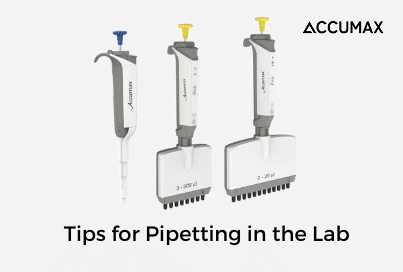Tips for Pipetting in the Lab

Take it from someone who has dealt with repetitive stress injuries for a long time: correct pipetting technique is crucial regardless of your position in the lab. Accuracy is the foundation of any excellent scientific experiment; without accurate pipetting technique, all measurements would be off, from reagent distribution to sample collection and processing. Here are a few pointers to help you improve your pipetting technique, making it easier and less tiring to reach high levels of accuracy and consistency.
Choose the appropriate pipette
The first thing to think about before starting an experiment is selecting an acceptable set of pipettes. No, I’m not talking about deciding between Gilson and Eppendorf, but everyone has a favorite pipette brand. I’m talking about planning ahead of time which pipettes will be needed throughout the workflow so you’re not scrambling at the last minute to find the one you need.
Remember that some studies necessitate a large volume of samples, making single-channel pipettes impracticable. Multichannel pipettes can be beneficial in these scenarios, however they are often used to pipette from solution reservoirs rather than sample tubes. They may also be useful when shifting volumes from one microplate to another.
Labeling pipettes may also be useful prior to pipette selection, particularly when designating pipettes for specialized purposes such as RNA handling or sterile use. It’s best to use labels that can withstand being sprayed with alcohol as well as any other substances your Lab pipettes may come into contact with.
Technique that is slow and steady
Accurate and reliable measurements require proper technique. Pipetting should be done slowly and steadily, especially when aspirating. It is recommended to pause for only a fraction of a second after aspirating to ensure that the required volume of liquid has been delivered into the pipette. When dispensing, keep an eye out for droplets on the side of the tip, which can alter the dispensed volume if present. The pipette tip should be lightly placed against the container wall, and dispensing should be done quickly, pressing down to the second level of the pipette to ensure all liquid has been withdrawn.
Setup of a sample
How often do you have liquid in your tip and rush to find the proper tube to pipette into, only to realize you haven’t labeled it yet? When it comes to averting disasters, setting up tubes and other containers before experimentation is recommended practice. It guarantees that all sample tubes are available and identified, avoiding surprises during critical tests. To ensure speed and accuracy, all tubes should be properly recognized using printed labels rather than handwriting. Handwriting can be sloppy, and any smudges before, during, or after pipetting may cause the user to lose track of the tube. Instead, employing color coded labels, especially for large sample volumes with varying conditions, can assist users in swiftly identifying the correct tubes. When combined with a thermal-transfer printer, they almost eliminate the possibility of smearing and misidentification.
Find a comfortable, ergonomic position
It is critical to find the proper position to reduce the risk of repetitive stress injuries (RSI). These injuries may appear unlikely, yet RSI is more common in lab professionals than in other jobs. According to one study, the prevalence of RSI was twice that of state employees who did not work in labs, and pipetting for more than 300 hours per year was a risk factor for RSI.1 Another study found that pipette users had a higher risk of RSI than non-pipette users, with virtually all who pipetted for 60 minutes or more complaining of hand pain.2
When determining an adequate pipetting position, sit comfortably with enough back support to maintain balance and avoid straining oneself by bending over. Keep your elbow locked tight, preferably planted on the bench adjacent to your samples, so that the effort you generate is focused on aspirating and dispensing liquid rather than keeping your arm steady. Avoid standing for lengthy periods of time since it puts undue strain on your legs and back, perhaps leading to long-term pain.
Take frequent pauses.
Taking frequent pauses is the greatest way to avoid an RSI, especially if you feel any strain in your wrist or fingers. Breaks in your experimental design should be planned for so that there are no surprises. This also helps to avoid circumstances in which you may begin to feel strain, even if your experiment demands you to pipet huge batches of samples as quickly as possible.
Keep your pipettes in good condition
Finally, depending on how busy your lab is, it’s worthwhile to invest in getting your pipettes calibrated once every 6 to 12 months. If you’re not sure if your pipettes need to be calibrated, you may always test their accuracy by placing a weigh dish on a scale and pipetting water onto it, assuming that 1 ml of water weighs 1 g. To prevent inaccuracies from infiltrating your workflow, this test should be performed before using any pipette for the first time, as well as after extensive use.

